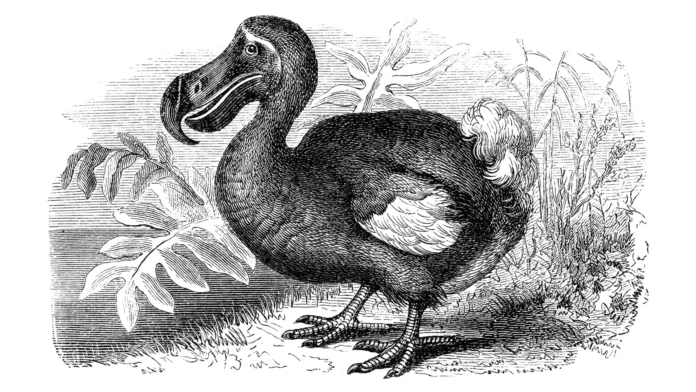Dodo is an extinct flightless bird. Its zoological name is Rephus cucullatus. It was living in the country Mauritius in the Indian Ocean. The closest living relative of the Dodo is the Nicobar pigeon. Since it is extinct, nothing is correctly known about the Dodo. Probably, it had brownish-grey plumage, yellow feet, a tuft of tail feathers, a grey, naked head and a black, yellow and green beak. It used gizzard stones to help digest its food. The main diet of the Dodo was fruits. The habitat of the Dodo was the woods in the dry coastal areas of Mauritius. Dodo was a flightless bird because of the easy availability of food and absence of predators.
The first recorded mention of the Dodo was by Dutch sailors in 1598. In the later time, the Dodo was hunted and killed by sailors for food. Its habitat was also destroyed. The Dodo was last sighted in 1662. Its extinction was not immediately noticed. Some could not believe that there was a bird called Dodo. Later on, the Dodo has been mentioned in the book Alice in Wonderland. The Dodo has become a symbol of extinction.
The earliest account of the Dodo was given by Van Warwijck in 1598. That is quoted below:
“Blue parrots are very numerous there, as well as other birds, among which are a kind conspicuous for their size, larger than our swans, with huge heads only half covered with skin as if clothed with a hood. These birds lack wings, in the place of which 3 to 4 blackish feathers protrude. The tail consists of a few soft incurved feathers, which are ash coloured. These we used to call ‘Walghvogel’, for the reason that the longer and often they were cooked, the less soft and more insipid eating they become. Nevertheless, their belly and breast were of a pleasant flavour and easily masticated.”
An Indian Mughal painting rediscovered in 1955 shows the Dodo along with native Indian birds. This painting is attributed to Ustad Mansur, during the time of Emperor Jahangir. The English traveller Peter Mundy claimed to have seen two Dodos between 1628 and 1633. Little is known about the behaviour of the Dodo. The male could reach the age of 21 and the female 17. It could run speedily. The legs were robust and strong to support the body.
Scientists have examined the brain of the Dodo; it is similar to that of modern pigeons.
About the egg of the Dodo, one English writer has written:
“They lay only one egg which is white, the size of a half penny roll, by the side of which they place a white stone the size of a hen’s egg. They lay on grass which they collect and make their nests in the forests. If one kills the young one, a grey stone is found in the gizzard. The fat is excellent to give ease to the muscles and nerves.”
The Dodo disappeared. It is very sad. The translation of the Dutch poem is as below:
“For food the seamen hunt the
flesh of feathered fowl.
They tap the palms and round-rumped Do… they destroy,
The parrot’s life they spare that he may peep and how,
And thus his feeling to imprisonment decoy.”
The poet Hilaire Belloc has written about the Dodo with sadness:
“The Dodo used to walk around,
And take the sun and air.
The sun yet warms his native ground
The Dodo is not there!
The voice which used to squeak and squeak
Is now ever dumb—
Yet may you see his bones and beak
All in the Museum.”
(The views expressed are the writer’s own.)

Radhakanta Seth is a Former Income tax officer in Sambalpur. He is a Freelance writer and his articles have been published in some Oriya dailies like Sambad, Samaj, Dharitri and English dailies like The Telegraph and in a sociological journal ‘Folklore’ published from Kolkata.
(Photo has collected from net )

